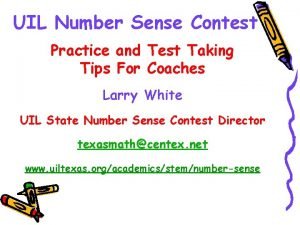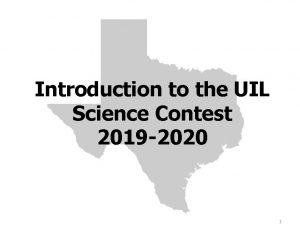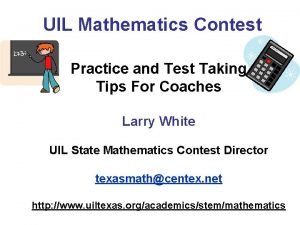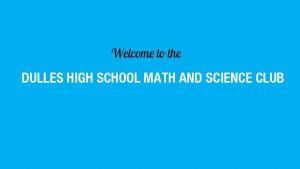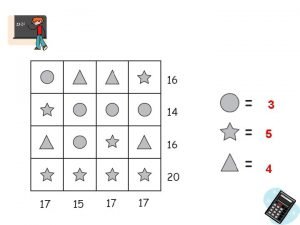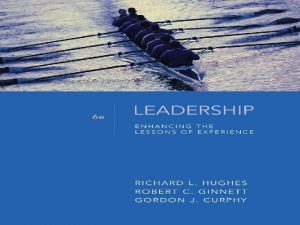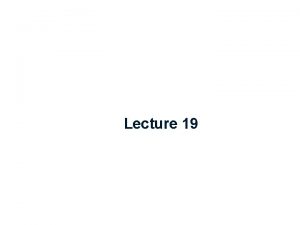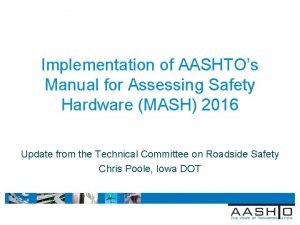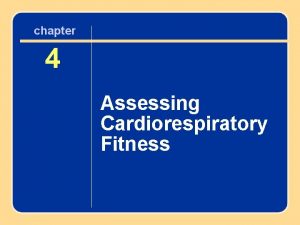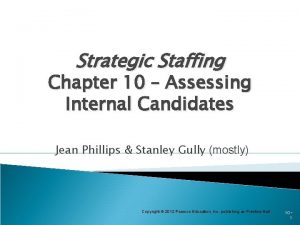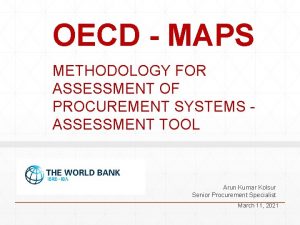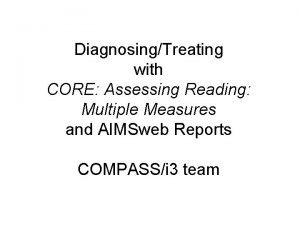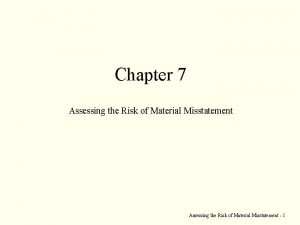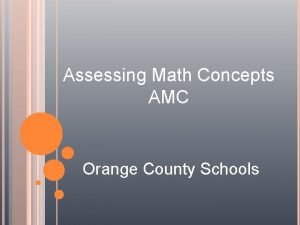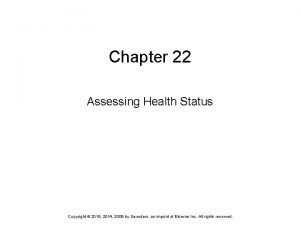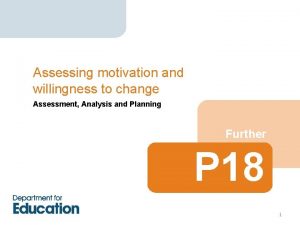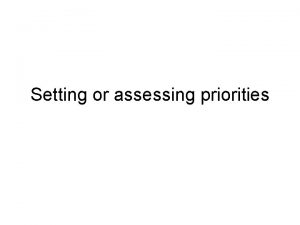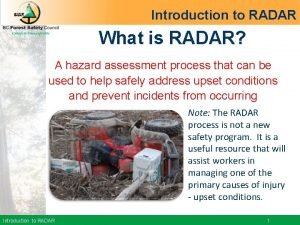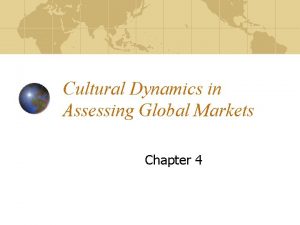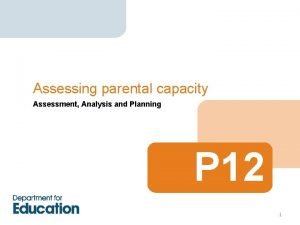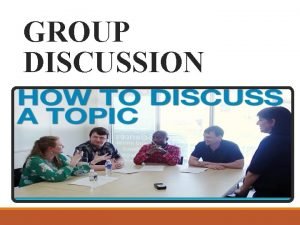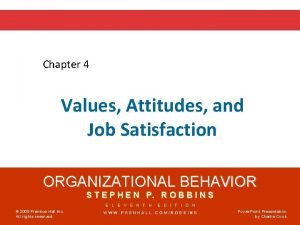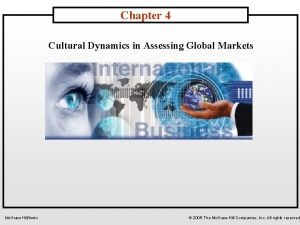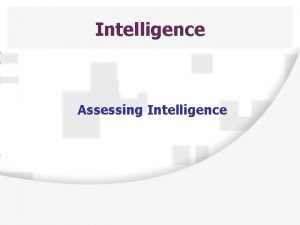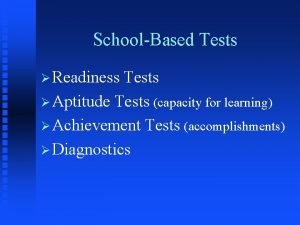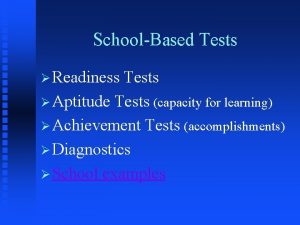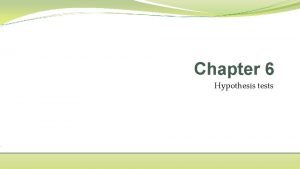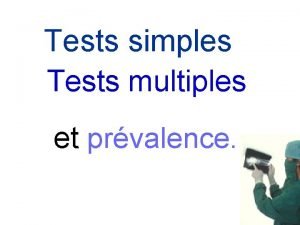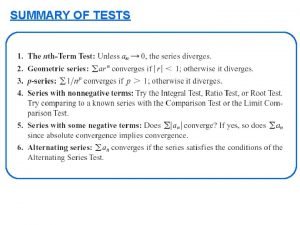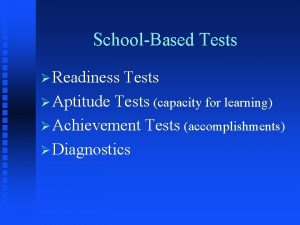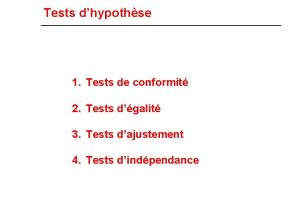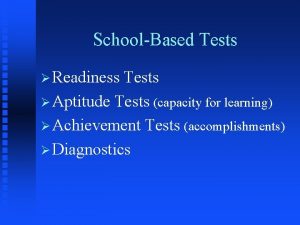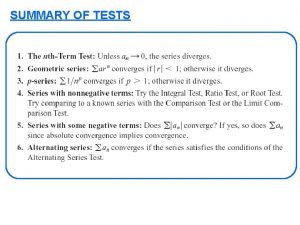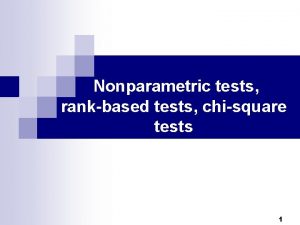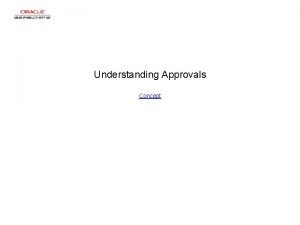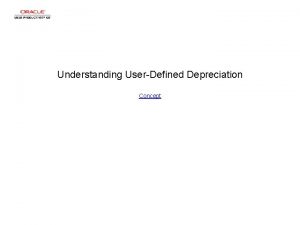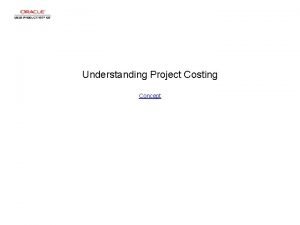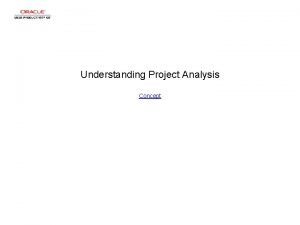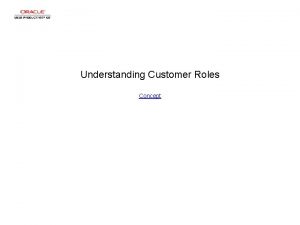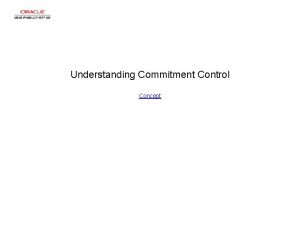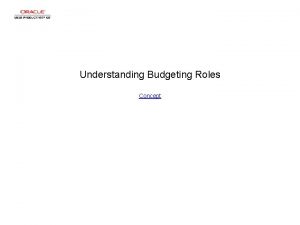Assessing Science Understanding Using Concept Tests and Concept


































- Slides: 34

Assessing Science Understanding Using Concept Tests and Concept Maps Joel J. Mintzes Consulting Research Scientist Science Education Department Harvard-Smithsonian Center for Astrophysics

2 July 22, 2012 Footer text here

Two Powerful Ways of Assessing Science Understanding Concept Tests Dark colored moths live on trees with a dark bark so birds can’t find and eat them. What do you think would happen if the trees were painted white? (Misconception 3) a) the number of dark moths would go up b) the number of dark moths would go down* c) the number of dark moths would not change d) some of the dark moths would turn white e) some of the dark moths would turn gray 3 July 22, 2012 Footer text here Concept Mapping

How Children Learn Science: A Few Facts Based on 40 Years of Research • Learners are not ‘empty vessels’ or ‘blank slates’. • They come to their first science classes with a finite but diverse set of ideas about natural objects and events • The ideas children bring to the classroom are often inconsistent with those offered by teachers and textbooks

How Children Learn Science: A Few Facts Based on 40 Years of Research • Many ideas that children bring to the classroom are the same regardless of age, gender and culture • They are found in all science disciplines: biology, chemistry, geology and physics • They serve a useful function in the everyday lives of children enabling them to make sense of things they experience

How Children Learn Science: A Few Facts Based on 40 Years of Research • The ideas that children bring to formal science instruction are tenacious and resistant to change by conventional teaching strategies

How Children Learn Science: A Few Facts Based on 40 Years of Research • The ideas that children bring to the classroom often interact with concepts presented by teachers and textbooks • The result of classroom interactions are a set of unintended learning outcomes • These unintended outcomes are typically not recognized by teachers or children themselves

How Children Learn Science: A Few Facts Based on 40 Years of Research • The ideas that children cling to often resemble the explanations of earlier generations of scientists and natural philosophers • Aristotle • La. Marck • Galen

How Children Learn Science: A Few Facts Based on 40 Years of Research • Children’s ideas are products of a diverse set of experiences, including: • Direct observation of objects and events • Peer culture • Everyday language • Mass media • Formal classroom instruction

How Children Learn Science: A Few Facts Based on 40 Years of Research • Classroom teachers often subscribe to the same ideas as the children they teach

How Children Learn Science: A Few Facts Based on 40 Years of Research • New instructional strategies are required to expose children’s ideas and help them acquire a scientific understanding of the world • The first step in any teaching strategy that seeks to enhance understanding is to reveal children’s pre-existing ideas • Two powerful methods for exposing children’s ideas are concept tests and concept maps

Using Concept Tests to Assess Science Understanding • The MOSART Project at Harvard-Smithsonian Center develops a large bank of Misconceptions Oriented Standards-based Assessment Resources for Teachers • Hundreds of assessment items based on the alternative conceptions research and field tested on a nationally representative sample of 30, 000 American elementary school children and their teachers • Available free of charge to all teachers at: https: //www. cfa. harvard. edu/smgphp/mosart/ 12 July 22, 2012 Footer text here

MOSART Concept Test Items • Misconceptions Oriented • Brumby, M. N. (1984). Misconceptions about the concept of natural selection by medical biology students. Science Education, 68(4): 493– 503. • Brumby, M. N. (1979). Problems in learning the concept of natural selection. Journal of Biological Education, 13(2), 119– 122. • Standards Based: • LS 4. B: NATURAL SELECTION • Genetic variation in a species results in individuals with a range of traits. In any particular environment individuals with particular traits may be more likely than others to survive and produce offspring. 13 July 22, 2012 Footer text here • Assessment Resources for Teachers: • Present day giraffes have long necks because: • a. they stretch them to reach the trees for food. • b. their ancestors adapted to have long necks over time. • c. giraffes with the longest necks are the strongest and most perfect. • d. their neck length increases their body temperature. • e. their neck length increases their speed

Now It’s Your Turn to Think! • The next 5 questions were among those given to thousands of American school children in grades 5 -8 [ages 10 -13] • Your job is to: • Select the correct answer • Predict the biggest misconception

Question 1. In the food chain shown below, how is energy passed from organism to organism? • a. As light energy. • b. As chemical energy. • c. As heat energy. • d. As electrical energy. • e. As energy of motion.

Question 1. In the food chain shown below, how is energy passed from organism to organism? • a. As light energy. [Biggest Misconception] • b. As chemical energy. [52% correct] • c. As heat energy. • d. As electrical energy. • e. As energy of motion.

Question 2. Which of the following can become extinct? • a. Plants, animals and microorganisms. • b. Plants and animals, but not microorganisms. • c. Only plants. • d. Only animals. • e. Only microorganisms.

Question 2. Which of the following can become extinct? • a. Plants, animals and microorganisms. [41% Correct] • b. Plants and animals, but not microorganisms. • c. Only plants. • d. Only animals [Biggest Misconception] • e. Only microorganisms.

Question 3. Present day giraffes have long necks because: • a. they stretch them to reach the trees for food. • b. their ancestors adapted to have long necks over time. • c. giraffes with the longest necks are the strongest and most perfect. • d. their neck length increases their body temperature. • e. their neck length increases their speed.

Question 3. Present day giraffes have long necks because: • a. they stretch them to reach the trees for food. [Biggest Misconception] • b. their ancestors adapted to have long necks over time. [32% Correct] • c. giraffes with the longest necks are the strongest and most perfect. • d. their neck length increases their body temperature. • e. their neck length increases their speed.

Question 4. A pond ecosystem is best defined as: • a. only the animals that live in the pond. • b. only the plants that live in the pond. • c. only the water in the pond. • d. both the living and the non-living things in and around the pond. • e. both the animals and the plants that live in and around the pond.

Question 4. A pond ecosystem is best defined as: • a. only the animals that live in the pond. • b. only the plants that live in the pond. • c. only the water in the pond. • d. both the living and the non-living things in and around the pond. [42% Correct] • e. both the animals and the plants that live in and around the pond. [Biggest Misconception]

Question 5. In a forest ecosystem (see picture in item on test), squirrels eat plant material and foxes eat squirrels. What would probably happen to the amount of plant material in this ecosystem if all the foxes suddenly died? At first, the amount of plant material would: • a. not change because foxes do not eat plants. • b. not change because other animals would move in to eat the squirrels. • c. decrease because the number of surviving squirrels would increase. • d. increase because there would be more room for plants to grow. • e. decrease because foxes protect the plants.

Question 5. In a forest ecosystem (see picture in item on test), squirrels eat plant material and foxes eat squirrels. What would probably happen to the amount of plant material in this ecosystem if all the foxes suddenly died? At first, the amount of plant material would: • a. not change because foxes do not eat plants. [Biggest Misconception] • b. not change because other animals would move in to eat the squirrels. • c. decrease because the number of surviving squirrels would increase. [54% Correct] • d. increase because there would be more room for plants to grow. • e. decrease because foxes protect the plants.

Using Concept Maps to Assess Science Understanding • Marine. Quest: a residential one-week summer environmental education program for middle school students that focuses on life in the ocean (University of North Carolina Wilmington) • Participants construct concept maps before and after the program • Concept maps are compared to those constructed by a matched group of non-participants (control) 25 July 22, 2012 Footer text here

Life in the Ocean (Pre-instruction maps) • On the first day of instruction all participants in the program constructed concept maps 65 • Maps were scored for structural complexity and content validity • A matched group of middle school students enrolled in a local school served as control subjects 26 July 22, 2012 Footer text here

Life in the Ocean (Post-instruction maps) • Control 27 July 22, 2012 Footer text here

Life in the Ocean (Control) 68 28 July 22, 2012 Footer text here

Comparing Pre and Post-Instruction Concept Maps 60 50 I III Mean Frequency 40 30 20 10 0 Pre Post July 22, 2012 Footer text here Post Concepts** Concepts Relationships** Relationships 2003 2006 Knowledge Structure Components 29 Pre

Comparing Pre and Post-Instruction Concept Maps 30 July 22, 2012 Footer text here

Concept Tests and Concept Maps Concept Tests 31 Concept Maps • Focus on content validity of domainspecific knowledge • Focus on content validity and structural complexity of domainspecific knowledge • Address explicit concepts and previously identified misconceptions • Address conceptual frameworks and relationships among concepts • Response set is convergent and welldefined • Response set is divergent and openended • Useful for assessing potential pitfalls and progression toward learning goals • Valuable for gaining insight into depth of understanding and coherence of knowledge base July 22, 2012 Footer text here

References Edited by Mintzes, Wandersee and Novak 32 July 22, 2012 Footer text here

References Concept Tests and Concept Maps CBE Life Sciences Education, 12(3): 553 -575 33 July 22, 2012 Footer text here Environmental Education Research, 14(5): 519 -536

MOSART Website: https: //www. cfa. harvard. edu/smgphp/mosart/ Contact me at: Science. Learning. Associates@gmail. com 34 July 22, 2012 Footer text here
 Ace different tests help iq tests
Ace different tests help iq tests My favourite subject
My favourite subject Tmsca practice tests
Tmsca practice tests Previous uil science tests
Previous uil science tests Math uil test
Math uil test Tmsca science study guide
Tmsca science study guide Tmsca math practice tests
Tmsca math practice tests Ways to address grammar in the writing classroom
Ways to address grammar in the writing classroom What are the 4 career stages of ppst
What are the 4 career stages of ppst Informal reading inventory examples
Informal reading inventory examples Assessing a new venture's financial strength and viability
Assessing a new venture's financial strength and viability Assessing leadership and measuring its effects
Assessing leadership and measuring its effects Module 4 topic 1 assessing and managing risk
Module 4 topic 1 assessing and managing risk Module 4 topic 1 assessing and managing risk
Module 4 topic 1 assessing and managing risk Assessing risk in sport
Assessing risk in sport Unit 18 assessing children's development support needs
Unit 18 assessing children's development support needs Assessing need for hrd
Assessing need for hrd Aashto manual for assessing safety hardware
Aashto manual for assessing safety hardware Cultural dynamics in assessing global markets
Cultural dynamics in assessing global markets Assessing cardiorespiratory fitness
Assessing cardiorespiratory fitness A nine box matrix requires assessing employees on ________.
A nine box matrix requires assessing employees on ________. Oecd maps
Oecd maps Core multiple measures
Core multiple measures Inherent risk
Inherent risk Assessing math concepts
Assessing math concepts Chapter 22 assessing health status
Chapter 22 assessing health status Assessing motivation to change
Assessing motivation to change Assessing opportunity cost involves
Assessing opportunity cost involves Hazard communication quiz answers
Hazard communication quiz answers Cultural dynamics in assessing global markets
Cultural dynamics in assessing global markets Assessing value for money
Assessing value for money Assessing parental capacity
Assessing parental capacity Factual topics for group discussion
Factual topics for group discussion The globe framework for assessing cultures
The globe framework for assessing cultures Cultural dynamics in assessing global markets
Cultural dynamics in assessing global markets


